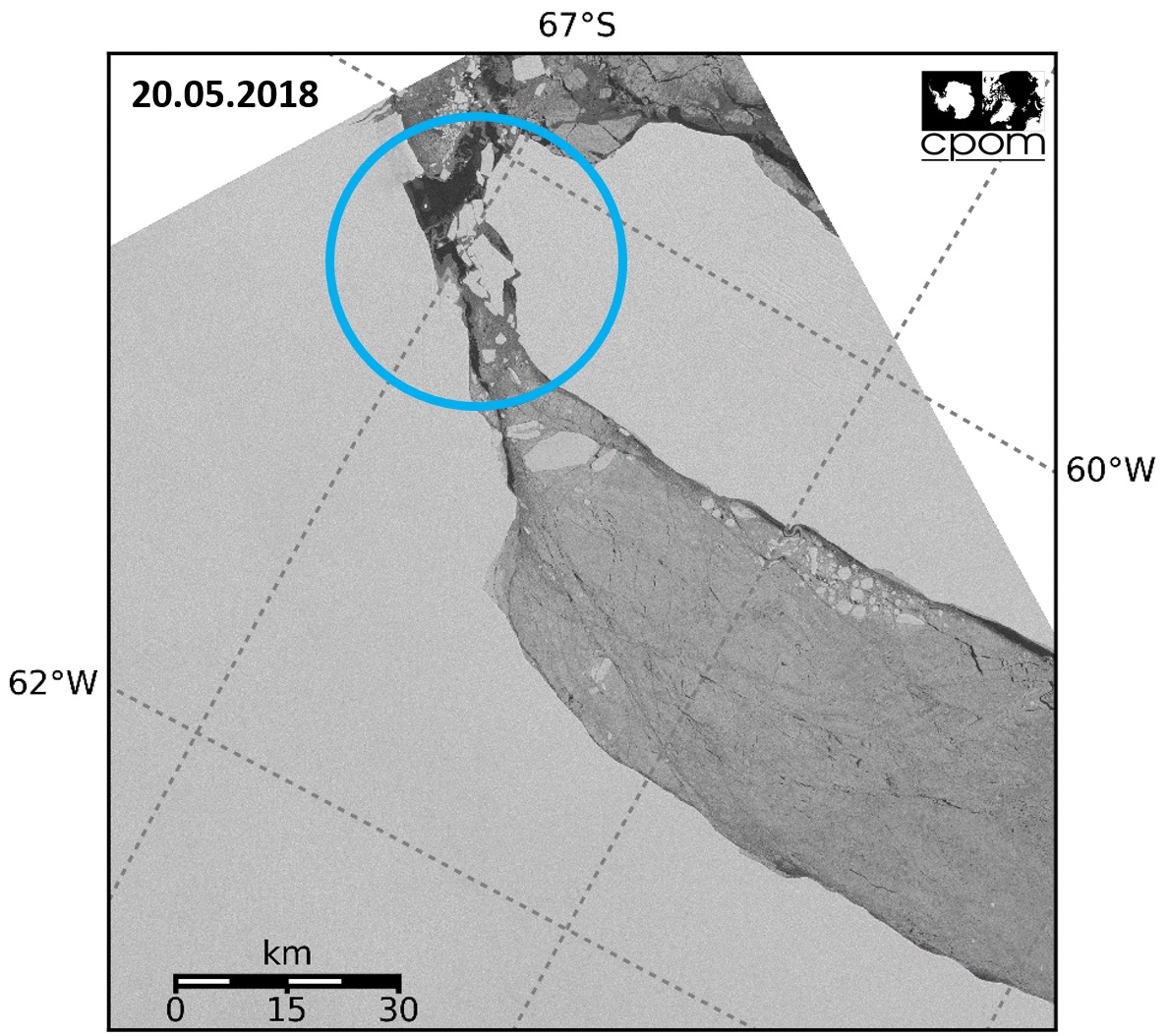Enormous Iceberg Pirouettes After Splitting from Ice Shelf

The Delaware-size iceberg that calved off Antarctica's Larsen C ice shelf in July 2017 is on the move.
The trillion-ton chunk of ice performed a graceful northerly pivot over the course of July and August, satellite imagery reveals. Polar oceanographer Mark Brandon of the Open University in England noted the berg's rotation on his blog, Mallemaroking.
The iceberg will probably bump around in its current location near the ice shelf that calved it for at least a few months, periodically getting stuck on shallow seamounts on the ocean floor, said Theodore Scambos, a senior research scientist at the National Snow and Ice Data Center in Colorado. [In Photos: Antarctica's Larsen C Ice Shelf Through Time]
"There are lots of little pinnacles that can snag an iceberg," Scambos told Live Science.
Berg on the move
The iceberg, dubbed A68 by scientists, broke off the Larsen C ice shelf sometime between July 10 and July 12, 2017. Researchers had been tracking a growing crack in the ice shelf via satellite for years, so the calving event was no surprise. At around 2,240 square miles (5,800 square kilometers) in surface area, the iceberg is among the largest observed since satellite tracking began.

The ability to observe the berg has made it famous beyond its actual scientific importance, Scambos said.
"We can make it kind of a daily event for people to watch and see how this massive piece of ice is on the move," he said. "I think, right now, it would be the biggest floating object on the ocean."
Sign up for the Live Science daily newsletter now
Get the world’s most fascinating discoveries delivered straight to your inbox.
A GIF created by polar scientist Anna Hogg of the University of Leeds shows the calving and motion of A68 since 2017. The iceberg is currently about 27 miles (45 km) away from the Larsen ice shelf, Hogg told Live Science in an email. A68 moved little in its first year of emancipation from the ice shelf, having snagged (or "grounded") on the bottom of the Weddell Sea. In particular, Scambos said, a small seamount called the Bawden Ice Rise pinned the berg in place.
The iceberg was bumping around in place like a bobbing bath toy. It mashed into the side of the Larsen ice shelf a handful of times in the past year, Hogg said, including incidents in May and June of this year that splintered off several smaller bergs.
Sometime around July 12, 2018, A68 broke free from some of its grounding and started to swing toward the north, like a clock hand moving in reverse, Brandon wrote in a statement sent to Live Science. The iceberg has since rotated about 90 degrees.
Currents' pull
The bumps and snags of A68 are interesting to track, Scambos said, but so far, the iceberg is behaving how scientists expected. As the tides ebb and flow, the berg will surf atop them, floating closer to, and then farther from, the ice shelf in a spiraling-type path, he said.
"Eventually, no matter what, with snags and twists and bends and probably a little bit of inherent rotation … it will drift to the north," he said. [Photos: Diving Beneath Antarctica's Ross Ice Shelf]
Bergs in this region end up floating on the currents past the tip of the Antarctic Peninsula, Scambos said, and finally get caught up in a current called the West Wind Drift, or Antarctic Circumpolar Current. This current will pull the berg into warmer waters, where it will break up and melt, Scambos said.
"I suspect the final breakup will happen in some summer period where there has been a lot of melting and flooding of the surface of the iceberg," Scambos said. Liquid water will flow into cracks on the berg's surface, fracturing them further and driving the ice apart from within. The final breakup could happen rapidly, Scambos said, within just a few days.
Scientifically more interesting, Scambos said, is what will happen to the seafloor that A68 leaves behind. The area from which the berg just swung free has probably not been exposed to the sky for 120,000 years, Scambos said. Because ice shelves block nutrients from reaching the ocean, the seafloor under shelves is usually nearly barren, he said. Now, that seafloor will suddenly be exposed to sunlight.
"It's sort of like the Oklahoma land rush for things that creep and crawl along the seabed that want to stake a claim," Scambos said.
Two 2019 expeditions are planned to study this phenomenon up close: one aboard the research vessel the Polarsternand another aboard the South African vessel Agulhas II, which will also search for the remnants of Sir Ernest Shackleton's ship Endurance. That vessel was trapped in ice and crushed in 1915, setting the stage for an extreme survival attempt as Shackleton and his men launched a lifeboat into the same currents that now drive A68's movements through the Antarctic seas.
Original article on Live Science.

Stephanie Pappas is a contributing writer for Live Science, covering topics ranging from geoscience to archaeology to the human brain and behavior. She was previously a senior writer for Live Science but is now a freelancer based in Denver, Colorado, and regularly contributes to Scientific American and The Monitor, the monthly magazine of the American Psychological Association. Stephanie received a bachelor's degree in psychology from the University of South Carolina and a graduate certificate in science communication from the University of California, Santa Cruz.









